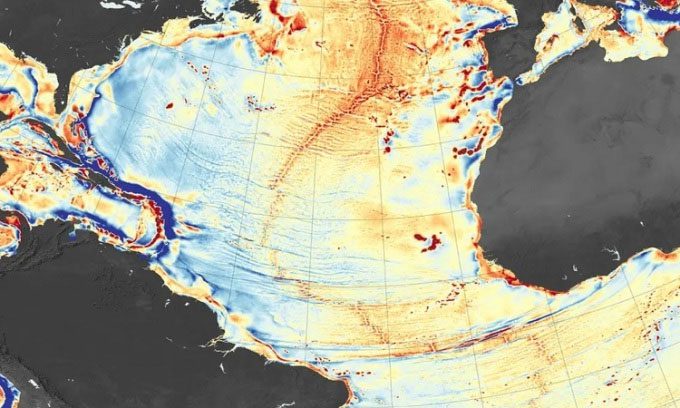The Atlantic Ocean is expanding by 4 cm each year due to material rising from deep within the mantle, pushing tectonic plates apart.
The tectonic plate beneath the Americas is separating from underneath Europe and Africa. However, the exact process of how and why this occurs remains a mystery to scientists, as the Atlantic Ocean lacks the dense subduction zones characteristic of the Pacific Ocean. A study published in 2021 in the journal Nature indicates that the key factor driving the expansion of the Atlantic Ocean lies beneath the mid-ocean ridge.
A series of submarine mountains known as the Mid-Atlantic Ridge (MAR) separates the North American tectonic plate from the Eurasian plate and the South American tectonic plate from Africa. Researchers found that material from deep within the Earth rises to the surface through the MAR, pushing the tectonic plates on either side of the boundary apart.

Mid-Atlantic Ridge (dark orange) on a bathymetry map from NASA’s Earth Observatory. (Image: NASA)
The mantle is 2,896 km thick, primarily in a solid state, surrounding the Earth’s core. The Earth’s crust is divided into several tectonic plates that fit together like a jigsaw puzzle. These plates interact in various ways, moving together, drifting apart, or sliding beneath one another. Seafloor spreading occurs when tectonic plates separate, allowing magma from within the Earth to rise to the surface. Another mechanism involves hot, soft rock rising from the mantle and being pushed to the surface by convection currents.
Any material pushed up beneath tectonic plate boundaries like the MAR typically starts from the mantle very close to the Earth’s surface, around 4.8 km deep beneath the crust. Material from the lower mantle, closest to the core, has not been detected at these depths. However, the 2021 study found that the MAR is a hotspot for convection. Researchers measured geological activity over an area of 1,000 km. They deployed 39 seismometers to the ocean in 2016 and left them for a year to collect global earthquake data.
Seismic waves traveling through the Earth’s core material provide scientists with insights into what happens in the mantle beneath the MAR. The research team found that magma and rock at 660 km beneath the mantle could be pushed up to the surface there. This upward movement of material is the reason for the tectonic plates and continents above separating at a rate of 4 cm per year.
“The upward movement from the lower mantle to the upper mantle and to the surface is often associated with localized sites like Iceland, Hawaii, and Yellowstone, not with mid-ocean ridges,” said Matthew Agius, a seismologist at Roma Tre University and co-author of the 2021 study. “This makes the study’s findings very interesting as they are completely unexpected.”
Typically, material moving from the lower mantle to the upper mantle is hindered by the dense rock layers in the transition zone at depths of 410 and 660 km. However, Agius and colleagues estimate that beneath the MAR, temperatures at the deepest part of the transition zone are higher than predicted, resulting in a thinner region. This is why material can more easily rise to the seafloor compared to other places on Earth.
Usually, tectonic plates move under the influence of gravitational forces, which pull denser parts of the plates into the Earth. However, the tectonic plates surrounding the Atlantic Ocean are not as dense, leading scientists to wonder what drives the tectonic plates’ movement if not gravity. The research findings suggest that the upward movement of material deep within the mantle may be the mechanism behind the Atlantic Ocean’s expansion. Catherine Rychert, a geophysicist at the University of Southampton, noted that this process began 200 million years ago and that the rate of expansion may increase in the future.


















































